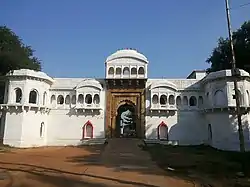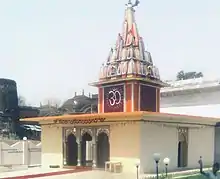Nai Garhi
Naigarhi meaning 'a new fortress' was founded by Raja Chattradhari Singh, a Sengar Rajput who migrated to this region after the destruction of his old fort in Mauganj by the Baghelas of Rewa State. It is a town and a nagar panchayat in Rewa district in the Indian state of Madhya Pradesh. It is notable for some monuments built by the Sengar clan, who ruled in the area before sovereignty. According to a survey, Naigarhi is one of the oldest inhabited villages in Madhya Pradesh.
Naigarhi
Naigarhi | |
|---|---|
 | |
 Naigarhi Location in Madhya Pradesh, India | |
| Coordinates: 24°47′15″N 81°46′54″E | |
| Country | |
| State | Madhya Pradesh |
| District | Rewa |
| Founded by | Chattradhari Singh |
| Population (2001) | |
| • Total | 9,767 |
| Languages | |
| • Official | Hindi |
| Time zone | UTC+5:30 (IST) |
| PIN | 486340 |
History

The town of Nai Garhi which means a 'new fortress' was established by Raja Chattradhari Singh of Sengar dyansty. According to the history of the region, he was a scion of the Sengar clan of Rajputs that ruled over a little kingdom known as Mauganj which was previously known as 'Mau Raj'. The Sengar kings arrived in Mauganj from Jalaun in the eleventh century and ruled as independent kings until fourteenth century. However, a new clan of Rajputs famously known as Baghelas invaded Mau Raj, destroyed the fort of Sengars and established the rule of Baghelas in the region which came to be known as Bagelkhand.[1]
One of the scions of the defeated Sengars was Chattradhari Singh who eloped to the Nai Garhi region and constructed a new fortress. According to the bards, the fort was first set to be built upon a land adjacent to the temple of Astha-bhuja (a varying form of goddess Durga) but the prince saw a dream where the goddess was ordering him to move to a different location. He ordered his troops that at the time of dawn, they would spot a wolf chasing a wild hare and the place where the wolf hunts the hare will be the sanctified location for the new fortress. The troops saw the exact sightings as discussed by the prince and ultimately found the location to built their fortress. The family chronicles state that the fortress was built by Raja Chattradhari Singh and the marvelous main gate known as the 'Hathi Darwaza' was built by his son Raja Hathi Raj Singh.
The rulers of this tiny principality maintained sovereign rule for a long period, however, they were unable to expand their dominion outside the circle due to the rising prowess of the Baghelas who established a cordial relationship with the Mughals and secured Bagelkhand by appointing numerous feudal lords. Essentially, the Sengars were still able to maintain their sovereignty until the arrival of the British in the region.
Battle of Sathni and Itar
In 1812, a group of Pindaris raided Mirzapur territory which forced the then king of Rewa, Raja Jai Singh to accede to a treaty with the British Raj. This first Anglo-Baghela treaty (1812) brought dissatisfaction in the region mostly among the Sengar Rajputs who started aggression against the British.[2]
In 1813, one Colonel Martindell reported in the region with a unit of Sepoys to quell the insurgency. A number of sepoys were killed and wounded at the behest of the Sengar Thakur whose headquarters was based in the village of Itar near Mangawan. This battle is still remembered in the folk song known as 'Itar ka Raisa'.[2] At some instance, the estate of Naigarhi was confiscated by the British who decided to reissue it to the then Thakur Jagat Bahadur Singh of Naigarhi, if the latter agreed to pay his dues and attended the Dussehara ceremonies held in the Rewa Durbar. The Thakur agreed and in 1882 the estate was re granted to the Sengar clan.[3]
Aftermath
The last feudal lord of Naigarhi was Thakur Gopal Sharan Singh. He was born in 1890 and went on to become a revered poet of Hindi poetry. The total worth of his estates were Rs. 90,000 per annum and an amount of Rs. 6,500 was paid to the Durbar.[4] He was awarded the title of 'Kavi Ratna' or the 'Gem among Poets'.[5] While residing in his Lal Kothi Mansion in Allahabad he build cordial relationships with great poets of his time like Maithili Sharan Gupt and Harivansh Rai Bachchan. The Higher Secondary School in Nai Garhi is named after him and every year a poet event is organised by the government in honor of Singh.
Politics
Naigarhi is under Deotalab vidhansabha. The first MLA of Deotalab was Thakur Someshvara Singh of Naigarhi which influenced the name and importance of Naigarhi in the regional politics. Naigarhi also started holding the Municipality elections.
Education
Naigarhi has a two government schools, boys and girls separate. The other private schools are regional board affiliated, Hindi mediums are Saraswati Shishu Mandir, Saraswati Gyan Mandir, Jeevan Jyoti, and an only English medium school is Lok Manya Tilak High School in Mahavirpur. The only college is named after Thakur Someshvara Singh comprising the studies of Arts and Commerce.
Tourism

The tourism frequency of Naigarhi is very low due to its distance from highways. A couple of waterfalls, the most famous one in the small village of Bahuti which is some 5 km away from Naigarhi, the famous Maa Asthabhuja temple, the Naigarhi fort, the Panchmandir temple and the iconic view of a typical Indian village can be seen in Naigarhi.

The Panchamandir is dedicated to Rama who is the main deity of the Sengar dynasty, Hanuman and Shiva. It resembles the fine stone carving art of the medieval India. There is also a temple dedicated to the goddess Kali which is located within the fort and is a popular tourist destination.
Festivities and culture
Apart from Durga Pooja in Dussherra, Diwali and Holi there is no festival which is celebrated here. But the Naigarhi fort has a reputation for decorating and celebrating Janamasthami with grandeur and holiness. Naigarhi fort also organises a holy feast called 'bhandara' in respect to the renovation of the Pancha-mandir temple in the precincts of the fort.
Demographics
As of 2001 India census,[6] Nai Garhi had a population of 8,767. Males constitute 51% of the population and females 49%. Nai Garhi has an average literacy rate of 50%, lower than the national average of 59.5%: male literacy is 63%, and female literacy is 36%. In Nai Garhi, 19% of the population is under 6 years of age.
References
- Baker, David E. U. (1 January 2007). Baghelkhand, Or, the Tigers' Lair: Region and Nation in Indian History. New York [N.Y.] ISBN 978-0-19-568321-9.
- Siddiqui, A. U. (2004). Indian Freedom Movement in Princely States of Vindhya Pradesh. Northern Book Centre. ISBN 978-81-7211-150-2.
- Baker, David E. U. (1 January 2007). Baghelkhand, Or, the Tigers' Lair: Region and Nation in Indian History. New York [N.Y.] ISBN 978-0-19-568321-9.
- India, Central (1928). Rulers, Leading Families and Officials in the States of Central India. Government of India, Central Publication Branch.
- Proceedings and Transactions of the ... All-India Oriental Conference. 1935.
- "Census of India 2001: Data from the 2001 Census, including cities, villages and towns (Provisional)". Census Commission of India. Archived from the original on 16 June 2004. Retrieved 1 November 2008.